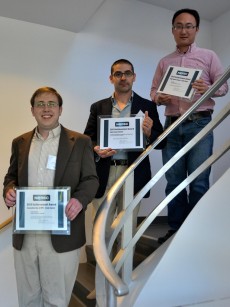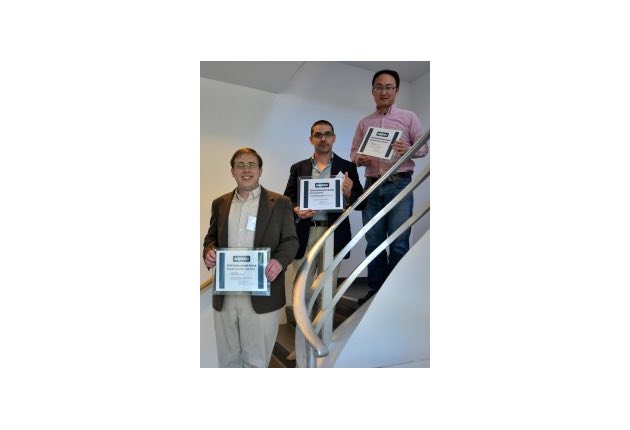
Third annual NERSC HPC Achievement Award winners: (left to right) Taylor Barnes, Caltech; Carlo Benedetti, Berkeley Lab BELLA program; and Ken Chen, UC Santa Cruz. Not pictured: Craig Tull. Image: Margie Wylie
This week NERSC announced the winners of its third annual HPC Achievement Awards. The awards recognize NERSC users who have demonstrated an innovative use of HPC resources to solve a scientific problem or whose work has had an exceptional impact on scientific understanding or society.
Winners include:
- Berkeley Lab’s BELLA team won the NERSC 2015 Award for High Impact Scientific Achievement. The Berkeley Lab Laser Accelerator team was honored in this category for its work using NERSC resources to design and configure the world’s most powerful compact particle accelerator. In 2014, a team of Berkeley Lab researchers led by BELLA Director Wim Leemans used BELLA to accelerate subatomic particles to the highest energies ever recorded from a compact accelerator. The researchers sped up the particles—electrons in this case—inside a nine-centimeter long tube of plasma. The speed corresponded to an energy of 4.25 giga-electron volts. The acceleration over such a short distance corresponds to an energy gradient 1,000 times greater than traditional particle accelerators and marks a world record energy for laser-plasma accelerators.
- Ken Chen won the NERSC 2015 Award for High Impact Scientific Achievement – Early Career. Chen, a post-doctoral researcher at the University of California, Santa Cruz, was honored in this category for his work using NERSC to study the explosion of very massive stars in multiple dimensions. In 2014, Chen was lead author on a study published in Astrophysical Journal that revealed that certain primordial stars—those between 55,000 and 56,000 times the mass of the Sun—may have died unusually. In death, these objects would have exploded as supernovae and burned completely, leaving no remnant black hole behind. Previously, it was thought that all stars over about 300 solar masses would collapse to black holes. This study also garnered much attention in the popular press, in large part because of the eye-catching visualizations Chen created using CASTRO—a multidimensional compressible astrophysics code developed at Berkeley Lab—and VisIT.
- Berkeley Lab’s SPOT Suite Team won the NERSC 2015 Award for Innovative Use of HPC. The team garnered this award for its work in beginning to transform the way scientists run their experiments and analyze data collected from DOE light sources. The SPOT Suite is a set of tools for reducing, managing, analyzing and visualizing beamline data that is transforming the way scientists run their experiments at Berkeley Lab’s Advanced Light Source (ALS) and other DOE light sources. It was developed through a collaboration between researchers from Berkeley Lab’s Computational Research Division, NERSC, the ALS and the Molecular Foundry.
While many of NERSC’s users are longtime users who have a consistent record of accomplishment, it’s important that we also acknowledge the innovative work of those in the formative years of their work, as evidenced by our Early Career award winners,” said Richard Gerber, leader of NERSC’s User Services Group. “These young researchers are the future of science and they bring new ideas, new perspectives and new energy to their chosen fields.”
In related news, Taylor Barnes from Caltech won the NERSC 2015 Award for Innovative Use of HPC – Early Career. Barnes is using NERSC resources to make outstanding methodological advances that advance our ability to harness large-scale computational resources for important chemical problems.




